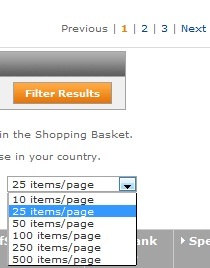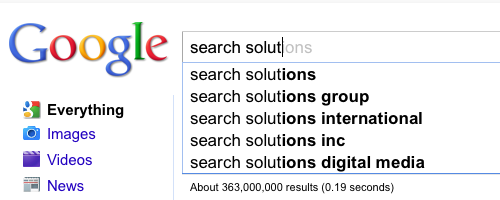Search is the second-most critical function on an ecommerce site, after the shopping cart checkout. Shoppers use site search even if they are familiar with the navigation of your site. You can relate to this by thinking of all the instances when you have gone to Amazon.com looking for a product and entered the search term in the search box instead of navigating the product catalog to get to that product.
Without effective site search, in short, merchants lose business. So, the question is, what is effective site search?
In my experience consulting with large online retailers, there are four ways to make search effective.
1. Search Reporting
Reporting helps identify a variety of metrics that can be used to enhance the user experience, improve search and increase revenue from your site. Some of the metrics that reporting can provide are as follows.
-
Identify frequently searched terms. This helps determine what consumers are looking for when they come to your site. You can use this data to reformat your site and focus on the most searched areas. For example, a site selling both TVs and laptops might see that most consumers are mostly searching for TVs. This information can help redesign the site to give TVs higher priority.
-
Determine location-based search terms. This helps with consumer segmentation. Using the example of the site that is selling TVs and laptops, the report will help determine patterns that show customers from a certain region purchase higher-end TVs compared to another region where lower-end TVs are in higher demand. This can help customize the user experience by offering different product recommendations on different product pages.
-
High-converting search terms. This report identifies the search terms that lead to the most purchases. This report is relatively more complicated to set up, as it integrates the search process with the checkout process. It is possible, however, that your search solution can provide this report. It is very helpful, as it determines which terms led to an actual purchase — your ultimate goal — and which terms failed to close the sale. Search can then be optimized accordingly for high converting terms.
Sample report of frequent search terms, with related conversion data.
- Terms with no search results. This report determines search terms that returned no results. It provides a huge opportunity by listing the terms that the consumer is using to find products on your site, though the search is returning zero results. As the site owner, you can update the site content to incorporate these search terms and then optimize the search results. This will potentially lead to improved revenue as now the consumer can search for the same terms and see applicable products in the search results.
2. Search Performance
Reporting will provide you with insights to improve search by understanding what works and what doesn’t. It does not help, however, if the search results are great, but the speed is poor. A consumer will not wait for more than five seconds for search results. If your results take more than five seconds, there are several actions to improve it.
-
Size of the search result. Check if each result has too much information — name, description, image, price, and features — that is being returned. Evaluate if all this information is needed by your consumer to make a purchase. Otherwise reduce the information returned
-
Number of search results. If your site has a lot of products, then you can limit the number of results that are returned. The results can be prioritized based on the popularity of search terms — see “Search Reporting” section, above — the profit from each product, and the combination of either option or any other option. Sometimes it is beneficial to implement pagination as part of the search results and returning only 20 to 50 items per page. This is relevant for sites that have many similar products and very patient consumers that select products from page 2 or beyond.
Restricting pagination can increase speed of search results.
- Other technical options. If the above two options fail to improve performance, try some other, more technical options. These involve tuning the search algorithm, tuning the search software, tuning the search hardware, and replacing the search software solution.
3. Search Results
The best search solution will not benefit your site unless your search results are returning the right content that interests your consumers.
Make sure the right content is available on the site. Products should have rich content associated with keywords and tags to allow search to easily find them. The keywords need to be reviewed on a periodic basis, as occasionally the same product can become associated with new keywords, such as a hot-selling product.
Next, make sure the search solution finds that rich content when someone searches for it. This requires aligning the information that shows up in the search results with the content that is stored on the site. It also requires your search solution to create an index of the site content on a frequent basis so that any new content that gets added to the search solution appears in the search results.
4. Search Features
Most search solutions come with several features that make it easier for your shoppers to find the products they are looking for. Some of these features are as follows.
-
“Did you mean?” Search solutions auto-correct a search term if the term has a typo or if it has been misspelled. Most search solutions offer this feature, though it requires some effort to maintain associations between misspellings or typos and the correct search terms.
-
Advanced search. Advanced search enables consumers to either drill down the search results further by selecting additional filters, or search using additional options, such as products that are on promotion or that offer free shipping. This feature also allows consumers to filter the search results by selecting specific product facets, such as TVs with a screen size larger than 50”, dresses that are a size 4, and so forth. This is an extremely useful feature that can help shoppers easily find the products that interest them. However, if your site has less than a hundred products, this feature will not provide much value.
-
Type ahead. This feature allows the search box to show options while the consumer is entering the search term. Google offers this feature and so do several other search vendors. This feature is helpful if your site has a lot of similar products or similar search terms. For smaller sites, this feature adds little value.
An example of Google’s type-ahead search feature.
-
Synonyms. This feature allows search to return results by including the synonyms of the search term as part of the search query. This is helpful if the products on the site can be searched using multiple terms. For example on travel sites, consumers search for both vacations and holidays and frequently use the terms interchangeably. If your site has this challenge, setting up synonyms will help.
-
Search in multiple languages. If your consumer base uses multiple languages, consider supporting multiple languages as part of search. If your entire site is multi-lingual, then it is easy to configure search to return non-English content when the consumer has selected a non-English language. Smaller sites in the U.S. usually cater to consumers that speak Spanish and English with only an English site. In this scenario, associate the Spanish search terms with their English counterparts in the English search results. This requires a good understanding of the consumer base and their search behavior.




